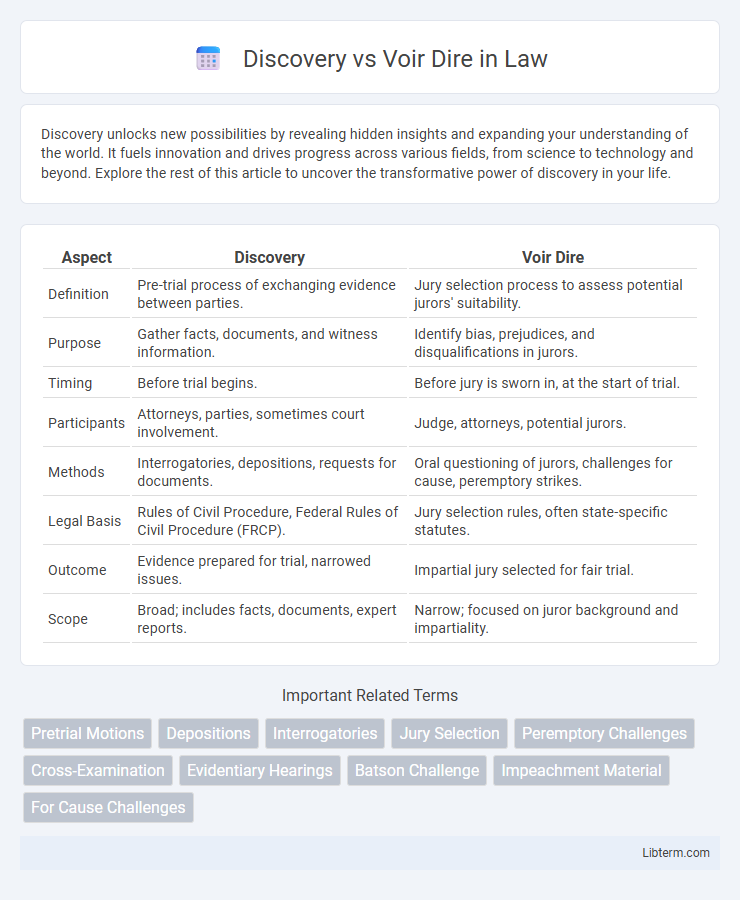Discovery unlocks new possibilities by revealing hidden insights and expanding your understanding of the world. It fuels innovation and drives progress across various fields, from science to technology and beyond. Explore the rest of this article to uncover the transformative power of discovery in your life.
Table of Comparison
| Aspect | Discovery | Voir Dire |
|---|---|---|
| Definition | Pre-trial process of exchanging evidence between parties. | Jury selection process to assess potential jurors' suitability. |
| Purpose | Gather facts, documents, and witness information. | Identify bias, prejudices, and disqualifications in jurors. |
| Timing | Before trial begins. | Before jury is sworn in, at the start of trial. |
| Participants | Attorneys, parties, sometimes court involvement. | Judge, attorneys, potential jurors. |
| Methods | Interrogatories, depositions, requests for documents. | Oral questioning of jurors, challenges for cause, peremptory strikes. |
| Legal Basis | Rules of Civil Procedure, Federal Rules of Civil Procedure (FRCP). | Jury selection rules, often state-specific statutes. |
| Outcome | Evidence prepared for trial, narrowed issues. | Impartial jury selected for fair trial. |
| Scope | Broad; includes facts, documents, expert reports. | Narrow; focused on juror background and impartiality. |
Understanding Discovery and Voir Dire
Discovery in legal proceedings involves the pre-trial phase where both parties exchange relevant information, documents, and evidence to build their cases. Voir Dire is the process of jury selection, during which attorneys question potential jurors to assess their impartiality and suitability for the trial. Understanding the distinction between Discovery and Voir Dire is essential for effective case preparation and ensuring a fair trial.
Key Differences Between Discovery and Voir Dire
Discovery involves the pre-trial process where both parties exchange relevant information, including documents, depositions, and interrogatories, to build their cases. Voir dire is the jury selection procedure during which attorneys and the judge question potential jurors to identify biases or conflicts that might affect impartiality. The key difference lies in discovery focusing on evidence gathering and case preparation, whereas voir dire centers on evaluating and selecting an unbiased jury for trial.
The Role of Discovery in Litigation
Discovery in litigation is the pre-trial process where parties exchange relevant information and evidence to build their cases, including documents, depositions, and interrogatories. It enables both sides to assess the strength of the opponent's claims or defenses, promoting fairness and reducing surprises during trial. Effective discovery helps streamline issues, supports strategic decision-making, and often facilitates settlement before voir dire and trial commence.
The Purpose of Voir Dire in Jury Selection
Voir dire serves as a critical process in jury selection aimed at assessing potential jurors' impartiality and suitability for a fair trial. Unlike discovery, which involves the exchange of evidence and information between parties, voir dire focuses on questioning jurors to identify biases, preconceived notions, or conflicts of interest. This procedure ensures an unbiased jury by allowing attorneys to challenge or exclude unsuitable candidates before deliberation begins.
Legal Procedures: Discovery vs Voir Dire
Discovery involves the pre-trial phase where parties exchange relevant information through interrogatories, depositions, and document requests to build their cases. Voir dire is the jury selection process conducted by attorneys and the judge to assess potential jurors' biases and suitability for the trial. While discovery uncovers evidence, voir dire ensures an impartial jury, both critical to fair legal proceedings.
Common Challenges in Discovery and Voir Dire
Common challenges in discovery include managing overwhelming volumes of electronic evidence and ensuring compliance with complex legal rules on privilege and confidentiality. Voir dire faces difficulties such as biased juror detection, balancing thorough questioning with time constraints, and navigating potential juror discomfort or evasion. Both phases demand meticulous attention to detail to protect party rights and guarantee a fair trial process.
Impact on Case Outcomes: Discovery vs Voir Dire
Discovery uncovers critical evidence and documents that shape the legal arguments and trial strategy, significantly influencing case outcomes by revealing facts that may support or weaken claims. Voir dire impacts case outcomes by enabling attorneys to select impartial jurors, ensuring a fair trial and reducing bias that could affect verdicts. Both processes complement each other by strengthening case preparation and promoting just decisions through comprehensive evidence evaluation and juror assessment.
Attorney Strategies for Discovery and Voir Dire
Attorneys approach discovery by meticulously gathering all relevant documents, witness statements, and expert reports to build a comprehensive factual foundation for the case. During voir dire, attorneys strategically craft targeted questions to identify potential juror biases and select a favorable jury composition. Effective use of discovery uncovers critical evidence, while voir dire enables attorneys to evaluate jurors' attitudes and ensure impartiality, both essential for trial success.
Recent Trends and Reforms in Discovery and Voir Dire
Recent trends in discovery emphasize increased transparency and efficiency through electronic discovery (e-discovery) tools, enabling faster data retrieval and analysis, while courts implement stricter guidelines to curb abuse and reduce costs. Voir dire reforms focus on enhancing impartiality by adopting standardized questioning procedures and incorporating juror analytics to better assess biases and ensure fair jury selection. These changes reflect an ongoing push toward balancing comprehensive fact-finding with protecting participants' rights and streamlining the litigation process.
Best Practices for Integrating Discovery and Voir Dire
Integrating discovery and voir dire effectively requires meticulous preparation to align evidence uncovered during discovery with targeted juror questioning, enhancing case strategy and jury selection precision. Employ iterative collaboration between legal teams and jury consultants to develop voir dire questions grounded in discovered facts, identifying potential juror biases related to case themes and key witnesses. Leveraging data analytics from discovery documents supports crafting voir dire narratives that optimize juror engagement and improve trial outcomes.
Discovery Infographic

 libterm.com
libterm.com